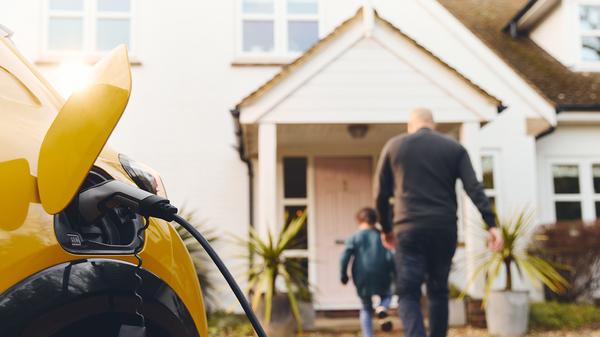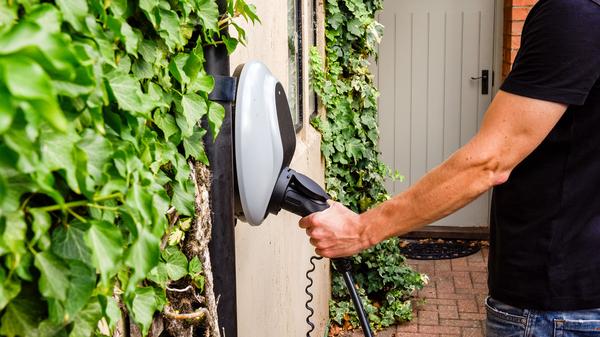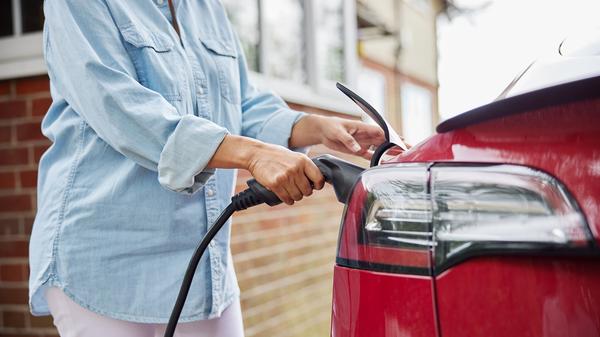Advice
Charging an electric car at home
From installing a home charge point to keeping your electric bill under control, here's our guide to charging your electric car at home.


Words by: Andrew Woodhouse

Additional words by: Mark Nichol
Last updated on 13 February 2024 | 0 min read
The most popular, and sensible, option for any electric car owner is to get a dedicated home charging point installed - usually known as a ‘wall box’. Having a home wall box means you can can leave your car to charge overnight, which is not only convenient but frequently the cheapest way to charge the battery. Lots of energy providers offer specific EV charging tariffs with cheaper unit costs during off-peak hours.
Home charging points are much faster than three-pin domestic sockets and have built-in safety features. To get one, you’ll need to be able to park your car somewhere private off-road, like in a garage or on a driveway. So, let's get started. After something specific? Jump to: • What is a home charging point? • Installing a home charge point • Cost of installing a home charging point • How much does it cost to charge my car at home? • How often should I charge an electric car from home? • Can I charge an electric car from the mains? • Maintaining your home charging point
Home charging points are much faster than three-pin domestic sockets and have built-in safety features. To get one, you’ll need to be able to park your car somewhere private off-road, like in a garage or on a driveway. So, let's get started. After something specific? Jump to: • What is a home charging point? • Installing a home charge point • Cost of installing a home charging point • How much does it cost to charge my car at home? • How often should I charge an electric car from home? • Can I charge an electric car from the mains? • Maintaining your home charging point
What is a home charging point?
A home charging point an external wall-mounted unit that comes with a connected charging cable or a socket to plug your cable into. It’s designed specifically to quickly and safely charge your electric car, with built-in protection to prevent overheating and make it weatherproof.
If you’re unsure about which one to go for, check out Autotrader’s handy new EV charging tool. Simply type in your registration, answer a few quick questions and you’ll be able to compare all of the EV home charging points that are suitable for your vehicle, best home charging point brands. Some even let you see how it would look in your home via augmented reality, so you can be sure you’re making the right decision.
If you’re unsure about which one to go for, check out Autotrader’s handy new EV charging tool. Simply type in your registration, answer a few quick questions and you’ll be able to compare all of the EV home charging points that are suitable for your vehicle, best home charging point brands. Some even let you see how it would look in your home via augmented reality, so you can be sure you’re making the right decision.

Electric car charging speeds (briefly) explained
The majority of wall boxes offer 7kW charging speed, because that’s the maximum that a typical household single-phase electricity supply will allow. Commercial properties tend to have three-phase power, which means they can offer charging speeds up to 43kW. There’s a bit of a catch, though…
All electric cars have an ‘onboard charger’ that converts AC power from your home into DC power to charge the car. Most EVs have a 7kW onboard charger, which means that even if you plug into a charging station rated at 22kW, say, it’ll still only take charge at a 7kW rate. Some electric cars have 11kW or even 22kW onboard chargers, meaning they’ll take that rate of charge when plugged into a faster unit drawing from three-phase power. Again, though, because the vast majority of homes have single-phase power, 7kW charging speed is the maximum you’ll get regardless of your car’s onboard charger. As a side note, public ‘rapid charging’ (50kW and above), which uses a CCS charging cable, bypasses the onboard charger to give maximum charging speeds. Our article on electric car charging speeds gives you much more detail on this.
All electric cars have an ‘onboard charger’ that converts AC power from your home into DC power to charge the car. Most EVs have a 7kW onboard charger, which means that even if you plug into a charging station rated at 22kW, say, it’ll still only take charge at a 7kW rate. Some electric cars have 11kW or even 22kW onboard chargers, meaning they’ll take that rate of charge when plugged into a faster unit drawing from three-phase power. Again, though, because the vast majority of homes have single-phase power, 7kW charging speed is the maximum you’ll get regardless of your car’s onboard charger. As a side note, public ‘rapid charging’ (50kW and above), which uses a CCS charging cable, bypasses the onboard charger to give maximum charging speeds. Our article on electric car charging speeds gives you much more detail on this.
Installing a home charging point
You should get your home charging points installed by qualified specialists.
If you own your home, installing a charging point shouldn’t be an issue – it’s your home, you can do what you like. That said, if your property is listed or you live in a conservation area, it's worth checking with your local planning department first. If you rent, you should get permission from your landlord. Some landlords are happy to have a charging point installed, as it makes the property more attractive in the future. Generally, installations will take a couple of hours. The installer will position and fix the charging unit and connect it to the mains (during which they may turn your power off). They’ll also connect your charging unit to the internet, so have your WiFi password ready. The installer should perform safety tests and ensure the home charging unit is ready for use and give you a demonstration, so you know how everything works. If you’ve any specific questions, speak to the installation firm themselves. The more you know in advance, the more painless it should be to get an installation.
If you own your home, installing a charging point shouldn’t be an issue – it’s your home, you can do what you like. That said, if your property is listed or you live in a conservation area, it's worth checking with your local planning department first. If you rent, you should get permission from your landlord. Some landlords are happy to have a charging point installed, as it makes the property more attractive in the future. Generally, installations will take a couple of hours. The installer will position and fix the charging unit and connect it to the mains (during which they may turn your power off). They’ll also connect your charging unit to the internet, so have your WiFi password ready. The installer should perform safety tests and ensure the home charging unit is ready for use and give you a demonstration, so you know how everything works. If you’ve any specific questions, speak to the installation firm themselves. The more you know in advance, the more painless it should be to get an installation.
Cost of installing a home charging point
Generally, you’re looking at somewhere between £800 and £1200 to have a home charging point installed. You may find units that are cheaper, so as ever, shop around to see what’s right for you. All charging units do the same basic job, and all can be operated using a smartphone app, but some include features like integrated screens to quickly display charging data.
There have been various government grants available to cover some or all of the cost of home charger installation for anyone that wanted one. The Electric Vehicle Homecharge Scheme covered 75% of the cost of a home charger for any homeowner up to a maximum of £350. But in April 2022 this was superceded by the EV Chargepoint Grant, which offers the same thing, but only to landlords and tenants who rent. There are currently no grants towards home charger installation for people who own their home.
There have been various government grants available to cover some or all of the cost of home charger installation for anyone that wanted one. The Electric Vehicle Homecharge Scheme covered 75% of the cost of a home charger for any homeowner up to a maximum of £350. But in April 2022 this was superceded by the EV Chargepoint Grant, which offers the same thing, but only to landlords and tenants who rent. There are currently no grants towards home charger installation for people who own their home.

How much does it cost to charge my car at home?
You can cut costs by charging overnight when electricity is on a lower tariff. Many charging units and electric cars have a timer function to let you take advantage of cheaper electricity.
Here’s what you need to know to figure out exactly how much it’s costing to charge and run your electric car.
Here’s what you need to know to figure out exactly how much it’s costing to charge and run your electric car.
1) Understand your home energy tariff
You need to know how much one kWh of energy costs you. If this isn’t clear on your bill or the online breakdown of the tariff you are on, call the customer services department of your energy supplier and ask. You may be on the same charge per unit 24 hours a day, or you might have a cheaper tariff overnight, typically between the hours of midnight and 5am.
2) Multiply the cost per kWh by the number of kWh your battery is capable of, as advertised by the manufacturer or dealer
You need to know the ‘usable’ capacity of your car’s battery, which is the amount of the battery dedicated to driving the wheels. For example, a Vauxhall Corsa Electric has a 50kWh battery, 46kWh of which is ‘usable’. (If you can’t find out the usable capacity, you can still use the total battery capacity to give you a good idea of costs) So, let’s say your energy is costing 20p per kWh, then filling your Corsa would cost 46kWh x £0.20 = £9.20. The same principle applies to a 20-80 percent charge, which is realistically the sort of charging owners do. That would be 60 percent of the battery, so 46kWh x 0.6 = 27.6kWh, then 26.7 x 0.20 = £5.34
This sounds like an awful lot of work, but do it once, note the answers, and then you know roughly what “a tank” is costing you.
This sounds like an awful lot of work, but do it once, note the answers, and then you know roughly what “a tank” is costing you.
3) Understand ‘miles per kilowatt hour’ efficiency
It’s important to understand ‘miles per kilowatt hour’, which is the EV equivalent of a miles per gallon efficiency rating. Like working out charging costs, you can do this manually by figuring out how many miles you’re getting between charges. Using the figures above, let’s say you charge your Corsa fully then drive until the battery drops to 50 percent. You’ve covered 80 miles, say. We therefore know that those 80 miles have used up 23kWh (half the usable battery capacity). So, 80 ÷ 23 = 3.5 miles per kilowatt hour, roughly. It follows that those 3.5 miles are costing you 20p in electricity alone, which means you’re paying just under 6 pence per mile.
As with petrol and diesel cars, efficiency varies a lot from one electric car to another. As a rough guide, you can expect anything from 2-4 miles per kilowatt hour.
As with petrol and diesel cars, efficiency varies a lot from one electric car to another. As a rough guide, you can expect anything from 2-4 miles per kilowatt hour.
4) Use your car’s computers to understand how much energy you’re using
You’ll probably be pleased to know that most electric cars have been designed to take the hassle away from analysing data. They’ll have a graphic on either the central infotainment screen or the instrument panel (often both) that tells you all sorts of great information - from how many miles you have left on the battery, to how long it will take to recharge the battery fully, and how many miles per kilowatt hour you’re doing.
5) Talk to your supplier about an electric car tariff
Energy providers have started to offer tariffs designed to suit electric car owners who need large doses of electricity most days. Such tariffs normally cost customers slightly more during the day, but slash the unit price during off-peak times, usually overnight. Octopus Energy’s EV charging plan, for example, currently charges 7.5p per kilowatt hour between 11.30pm and 5.30am, compared to a day rate of 29.6p (February 2024). Remember, too, to set other household appliances with timers to run during that period, like the dishwasher.
6) Switch to a sustainable domestic electricity provider
Options include Octopus and Ecotricity. Choosing a sustainable electricity supplier will decrease your carbon footprint, silencing critics of electric cars who ask where the electricity is sourced from. Octopus invests heavily in solar power and also offers to buy any energy your property gathers via solar panels or battery storage. Ecotricity’s energy is certified green and vegan.

How often should I charge an electric car from home?
Your electric car will occasionally need a full charge and doing so can prolong battery life and health by flushing the battery through (just like a smartphone). If you’re due a full charge, make the most of the overnight electric rates.
For the most part, you’ll just need to top your car battery up two or three times a week for a couple of hours at a time. In some electric cars, you can schedule when your car starts charging via the car’s smart scheduling features. Alternatively, some chargers come with smart apps that you can schedule your charging through.
For the most part, you’ll just need to top your car battery up two or three times a week for a couple of hours at a time. In some electric cars, you can schedule when your car starts charging via the car’s smart scheduling features. Alternatively, some chargers come with smart apps that you can schedule your charging through.
Can I charge an electric car from the mains?
Technically you can charge your car from the mains, but we’d recommend this is only done as an emergency back-up.
The average three-pin socket has a maximum 3kW power rating and charging a car will have your socket running at 2.3kW (close to maximum). Doing this for hours at a time puts a lot of strain on your circuits and can be hazardous for both your EV’s computer and your wiring. It’s a fire risk and could ruin your car. Aside from that, it’ll take a lot, lot longer to charge your car. If you must use the mains for emergencies, make sure the extension lead you use is rated at 13amps and is properly insulated and unwound to reduce the risk of overheating.
The average three-pin socket has a maximum 3kW power rating and charging a car will have your socket running at 2.3kW (close to maximum). Doing this for hours at a time puts a lot of strain on your circuits and can be hazardous for both your EV’s computer and your wiring. It’s a fire risk and could ruin your car. Aside from that, it’ll take a lot, lot longer to charge your car. If you must use the mains for emergencies, make sure the extension lead you use is rated at 13amps and is properly insulated and unwound to reduce the risk of overheating.
Maintaining your home charging point
Home charging points don’t tend to require much maintenance, but some upkeep can go a long way.
• Store your charging cable safely to avoid damage or twisting • Keep the charging point clean and free from dust and muck • If you’re not using the charging point, shut it down to prolong its life. As they’re outside, they will be exposed to the elements, so they’ll need an annual service to ensure everything still works properly. Ensure you pick a qualified engineer.
• Store your charging cable safely to avoid damage or twisting • Keep the charging point clean and free from dust and muck • If you’re not using the charging point, shut it down to prolong its life. As they’re outside, they will be exposed to the elements, so they’ll need an annual service to ensure everything still works properly. Ensure you pick a qualified engineer.
